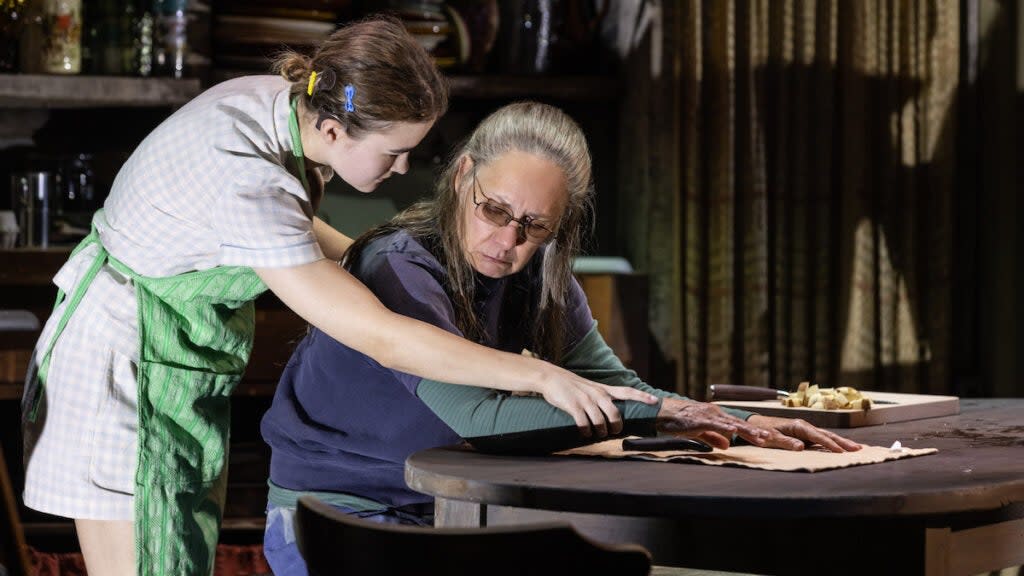‘Grey House’ Broadway Review: Laurie Metcalf’s Horror Play Delivers a Funny Mommie Weirdest

- Oops!Something went wrong.Please try again later.
- Oops!Something went wrong.Please try again later.
It may be the scariest moment in what is supposed to be a scary play. Early in “Grey House,” one of the five children who live in the blizzard-afflicted cabin of the title removes the boot of a severely injured stranger and carries it downstage, where it is thrown into a basket filled with nearly identical brands of manly footwear. In other words, what we are about to witness on stage is a ritual. Everything has not just happened before, it has taken place many, many times before. Written by Levi Holloway, this new horror play under the direction of Joe Mantello opened Thursday on Broadway at the Lyceum Theatre after a 2019 run in Chicago.
“Grey House” starts scary with that big boot being dropped into a pile of other big boots. Even earlier, as the curtain ascends in the totally dark theater, there is Tom Gibbons’s sound design that never stops punctuating the air with creaking wood and blowing wind and moaning humans. Scott Pask’s creepy set all but reeks of rot. And what are those things hanging from the ceiling? Rabid bats? Discarded fetuses? Natasha Katz’s lighting is so sparse that we never know for sure, but during several longueurs to come, those suspended objects do give us something to contemplate.
Also Read:
‘Primary Trust’ Off Broadway Review: William Jackson Harper Gives Imaginary Friends a Good Name
Laurie Metcalf plays the matriarch of this brood, and without giving too much away, her character, named Raleigh, has something in common with the title character in “The Flying Dutchman.” Rather than wandering the sea in search of a woman’s love, Raleigh is trapped in a cabin, waiting for a man, Henry (Paul Sparks), and his female companion, Max (Claire Karpen subbing for Tatiana Maslany), to crash their car outside the cabin so that she and the kids can frighten the bejesus out of them.
“Grey House” could be staged in such a way that the play begins with a semblance of normalcy and then slowly get weird. Mantello takes the opposite approach. His direction exhausts every cliché of stage terror about half an hour into this 100-minute one-act. In addition to the considerable contributions of the design team, the youngest child (Eamon Patrick O’Connell) is a refugee from the classic sci-fi horror film “Village of the Damned.” The oldest (Sophia Anne Caruso) is 16 going on 60 in the best Pamela Franklin fashion from a number of vintage 1960s movies. The explanations of the children’s bizarre names, which range from Squirrel to A1656, are especially twisted and tortuous, and not in a good way. Other female characters use traditionally male names, like Marlow and Max, which is never explained — a blessing.
And there’s other weird stuff right at the top: The contents of the refrigerator keep changing; when it doesn’t feature eggs and milk, jars of what appear to contain finely aged urine take their place. What might be a ghost (Cyndi Coyne impersonating an all-American Miss Havisham) pops up out of nowhere, each appearance inducing less shock. By the time Max screams in terror upon seeing the ghost late in the play, the audience does not join her. We’re already bored with the creature.
Also Read:
‘The Color Purple’ Musical Showcases Halle Bailey and Fantasia Barrino in Bold First Trailer (Video)
Stories of horror are fantastical, but need to follow their own inner logic once the parameters of that fantasy have been established. One game played in “Grey House” dictates that a mother will die if the “it” person tells a lie. Well, many lies are told and Raleigh, while tortured, somehow survives. If she’s the kids’ mother, why doesn’t she die? If she isn’t their mother, why is she tortured by these lies? Raleigh survives because if she didn’t, “Grey House” would end well before Holloway delivers his climax, which is a very unappetizing dinner party that involves way too much exposition to make narrative sense of what’s happening.
The play’s theme of male toxicity takes physical form in the contents of the fridge and what is extracted from Henry during the dinner party. Sparks makes for a most lovable bad guy, “because that’s what men do,” we’re told.
Metcalf plays Metcalf, being ornery and tough. Her role is hardly a leading one. She shows up occasionally, as if from another play, to badmouth the children around her. Her Mommie Weirdest performance provides a number of belly laughs.
Also Read:
Tony Awards Predictions 2022: Will ‘Six’ Block a ‘Strange Loop’ Sweep?

